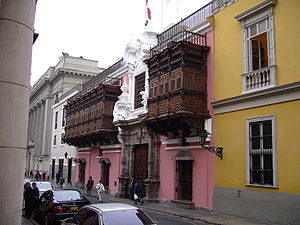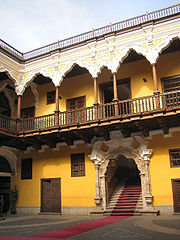
Torre Tagle Palace
Encyclopedia


Spanish Baroque
Spanish Baroque is a strand of Baroque architecture that evolved in Spain and its provinces and former colonies, notably Spanish America and Belgium....
palace located at Jr. Ucayali 363, in downtown Lima
Lima
Lima is the capital and the largest city of Peru. It is located in the valleys of the Chillón, Rímac and Lurín rivers, in the central part of the country, on a desert coast overlooking the Pacific Ocean. Together with the seaport of Callao, it forms a contiguous urban area known as the Lima...
, Peru
Peru
Peru , officially the Republic of Peru , is a country in western South America. It is bordered on the north by Ecuador and Colombia, on the east by Brazil, on the southeast by Bolivia, on the south by Chile, and on the west by the Pacific Ocean....
, a couple blocks east of the Plaza de Armas
Plaza de Armas
The Plaza de Armas is the name for the main square in many Latin American cities. In Mexico this space is known as El Zócalo, and in Central America as Parque Central...
. The palace currently is home to the Peruvian Ministry of Foreign Affairs
Ministry of Foreign Relations (Peru)
The Ministry of Foreign Relations of Peru is the statal entity of the Executive in charge of prepare and execute the foreign politics of the Peruvian State. It works in coordination with Peruvian ambassadors and consuls with accrediting in different countries and with international organizations...
.
The palace was commissioned in 1715 (some say 1730) by Don Jose Bernardo de Tagle y Bracho: 1st Marqués of Torre Tagle, who at the time was treasurer of the Royal Spanish fleet, for his own personal use as his home.
The exterior of the palace has a baroque
Baroque
The Baroque is a period and the style that used exaggerated motion and clear, easily interpreted detail to produce drama, tension, exuberance, and grandeur in sculpture, painting, literature, dance, and music...
stone doorway. The main facade is made from stone in the first wing and plaster in the second. The style is Sevillian baroque with a strong Mudéjar
Mudéjar
Mudéjar is the name given to individual Moors or Muslims of Al-Andalus who remained in Iberia after the Christian Reconquista but were not converted to Christianity...
influence. The materials used in its construction were brought from Spain, Panama
Panama
Panama , officially the Republic of Panama , is the southernmost country of Central America. Situated on the isthmus connecting North and South America, it is bordered by Costa Rica to the northwest, Colombia to the southeast, the Caribbean Sea to the north and the Pacific Ocean to the south. The...
and Central America.
Apart from carved columns, the palace is distinguished by two finely worked balconies in dark wood. These balconies (or miradors) adapt the European architecture to vernacular Peruvian tradition. The interiors feature Sevillian tiles, plasterwork, wooden columns, lobed Moorish arches and soaring coffered ceilings. It is considered to have a true "Limeño" architectural originality, harmoniously combining Andalusia
Andalusia
Andalusia is the most populous and the second largest in area of the autonomous communities of Spain. The Andalusian autonomous community is officially recognised as a nationality of Spain. The territory is divided into eight provinces: Huelva, Seville, Cádiz, Córdoba, Málaga, Jaén, Granada and...
n, Moorish, Criollo
Creole peoples
The term Creole and its cognates in other languages — such as crioulo, criollo, créole, kriolu, criol, kreyol, kreol, kriulo, kriol, krio, etc. — have been applied to people in different countries and epochs, with rather different meanings...
and Asia
Asia
Asia is the world's largest and most populous continent, located primarily in the eastern and northern hemispheres. It covers 8.7% of the Earth's total surface area and with approximately 3.879 billion people, it hosts 60% of the world's current human population...
n features.
The public cannot easily visit the inside, but some visits can be made by appointment only at the office of 'Imagen Institucional del organismo público'.
Similar mansions
Across the street from Torre Tagle, Casa Goyeneche (also called Casa de Rada) is another impressive 18th-century mansion, with distinct French influences. Other interesting similar sites that are nearby (in downtown Lima) are:- Casa Negreiros, Jr. Azángaro 532
- Casa de las Trece Monedas, Jr. Ancash 536
- Casa Barbieri, Jr. Callao at Rufino Torrico
- Casa de Pilatos, Jr. Ancash 390
- Casa la Riva, Jr. Ica 426.

